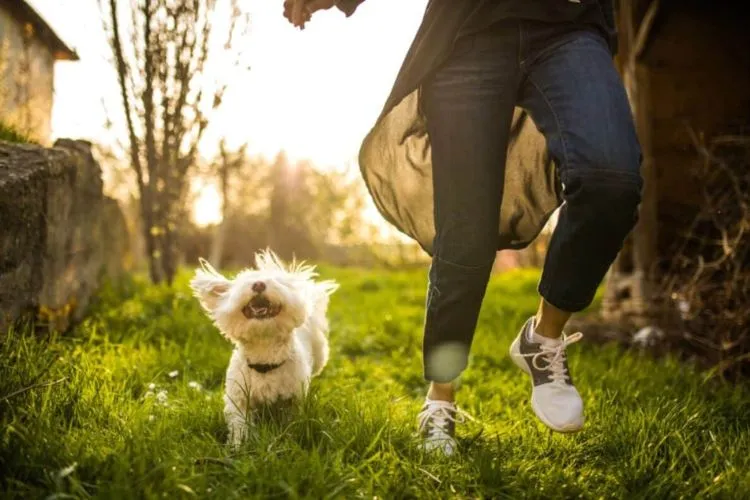As a dog owner, it’s troubling to watch your furry companion struggle with anxiety.
Dogs, like humans, experience anxiety for various reasons and exhibit it through a range of behaviors and physical signs.
It’s crucial for pet owners to recognize these signs and understand the methods to effectively calm their pets.
This comprehensive guide on how to calm an anxious dog delves into the causes of canine anxiety, identifies symptoms, and offers practical solutions to create a soothing environment for your pet.

🐾 Understanding Dog Anxiety
Before you can help your dog manage anxiety, it’s important to comprehend what triggers this condition. Canine anxiety often stems from past experiences, environmental factors, and sometimes, genetic predisposition.
Separation anxiety, for example, affects dogs who become distressed when away from their owners. Noise phobia is another common trigger, where loud sounds such as fireworks or thunderstorms may cause panic.
Additionally, a change in environment or routine can be other sources of stress for your pet. It’s also essential to recognize the various ways dogs exhibit anxiety.
Physical and behavioral signs are often the most noticeable. You might observe your dog pacing, panting, or shivering when they’re nervous.
Behavioral changes can include frequent urination, chewing on furniture, or even aggression. By closely observing your dog, you can identify patterns that indicate anxiety.
🐾 How to Calm an Anxious Dog?
Creating a stable and safe environment is the first step in mitigating your dog’s anxiety. Start by designating a quiet space in your home where your dog can retreat when overwhelmed.
This area should include their favorite toys, a comfortable bed, and perhaps an article of clothing with your scent for comfort.
In addition to creating a safe space, consider using calming aids. Products like pheromone diffusers release a chemical that mimics the natural pheromones of mother dogs, which can have a soothing effect.
Calming wraps or anxiety vests apply gentle pressure to the body, similar to the way swaddling soothes an infant. Soothing music formulated for dogs can also reduce stress, with studies suggesting that classical music, in particular, has a calming effect on canines.
Behavioral training techniques like desensitization and counterconditioning can help your dog become accustomed to stressful triggers over time.
Positive reinforcement can reinforce good behavior and create a more confident, less anxious dog. With patience and consistency, these training strategies can be highly effective.
🐾 Lifestyle Adjustments That Help
Maintaining a predictable routine is key to reducing a dog’s anxiety levels. Dogs thrive on routine and knowing what to expect from their day can greatly ease their anxiety.
Exercise is equally important, as regular physical activity helps to burn excess energy and produce endorphins, which have natural calming effects.
Diet also plays a role in a dog’s mental health. Some pet owners find that adding supplements like omega-3 fatty acids or amino acids like L-Theanine can help manage anxiety.
However, it’s crucial to consult with a veterinarian before making any changes to your dog’s diet.
🐾 When to Seek Professional Help?
While home remedies can be effective, severe anxiety may require professional intervention. If you notice persistent signs of distress in your dog that aren’t alleviated by the methods you’ve tried, it’s time to seek help from a veterinarian or an animal behaviorist.

They can offer tailored advice, potentially prescribe medications, and even recommend a professional dog trainer specialized in anxiety issues.
Understanding and addressing dog anxiety can be a complex process, but with patience and the right methods, it’s possible to soothe your anxious dog. By taking these steps, you can help your dog live a happier, more relaxed life.
Remember to monitor your dog’s progress and consult a professional if you have concerns about their mental well-being.
🐾 Signs of Anxiety in Dogs: Recognizing Behavioral and Physical Clues
Recognizing the signs of anxiety in dogs goes beyond the obvious symptoms of pacing and whining. Subtler indicators can provide insight into your dog’s emotional state, crucial for early intervention and management.
Behavioral clues include excessive licking or grooming, which is often overlooked but may signal stress if it leads to bald spots or skin irritation. Avoidance behaviors, such or hiding or refusing to engage in normal activities, can also point to anxiety.
Physically, an anxious dog might display dilated pupils or show the whites of their eyes more than usual, a sign known as whale eye. Changes in body posture, such as tucking their tail or flattening their ears against their head, are other key indicators.
Additionally, unexplained cases of diarrhea or sudden loss of appetite can be linked to stress or anxiety. By tuning in to these less conspicuous behaviors and physical reactions, pet owners can better understand their dogs’ emotional well-being and take steps to alleviate their distress.
🐾 The Impact of Routine and Training on Anxiety
A structured daily routine is a cornerstone of anxiety prevention in dogs, offering a sense of predictability and security. Regular feeding times, walks, and play sessions help to establish a sense of normalcy, reducing stress caused by uncertainty.
Consistent training further supports this by setting clear expectations and strengthening the bond between pet and owner. Positive reinforcement techniques encourage calm behavior and build confidence, which can mitigate anxious reactions.
Training that focuses on obedience and tasks gives dogs a sense of purpose and accomplishment, redirecting potential anxious energy into constructive activities, thus helping to keep anxiety at bay.

🐾 Frequently Asked Questions (FAQs)
Anxiety in dogs can be triggered by separation from their owners, loud noises like fireworks or thunder, change of environment, or routine. Other factors include past trauma, lack of socialization, or genetic predisposition.
While any dog can experience anxiety, some breeds, such as German Shepherds, Labrador Retrievers, and Cocker Spaniels, are more prone to anxiety disorders due to their genetic makeup and temperament.
Signs that your intervention is working include a noticeable decrease in anxious behaviors, more relaxed body language, and an increased amount of calm behavior. It’s essential to track these changes over time to understand the effectiveness of your approach.
While some dogs may overcome their anxiety completely, others may continue to show symptoms but can learn to manage them effectively. The goal is to reduce anxiety to a level where it doesn’t significantly impact the dog’s quality of life.
Conclusion:
In conclusion, calming an anxious dog requires patience, understanding, and a consistent approach.
Employing techniques like creating a peaceful environment, using soothing music, engaging in exercise, and considering supplements, or consulting a veterinarian for severe cases can significantly aid in reducing a dog’s anxiety, ensuring a happier, healthier life for your furry friend.
